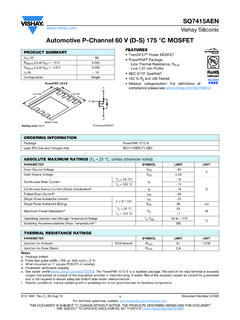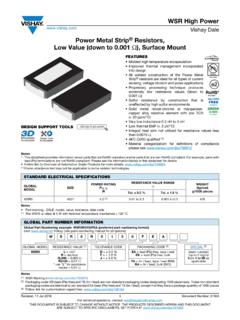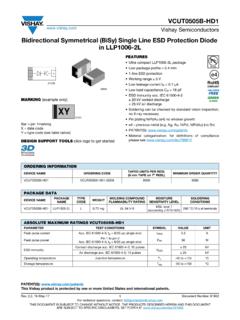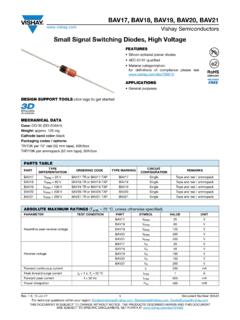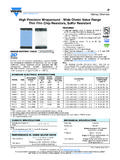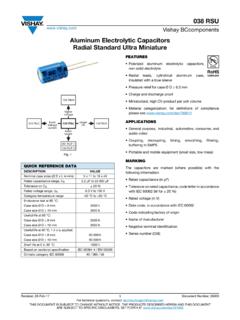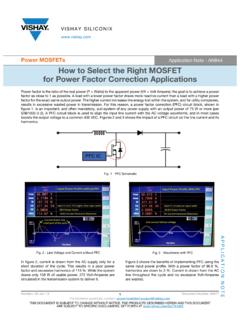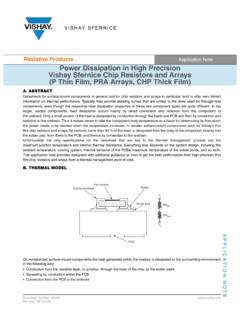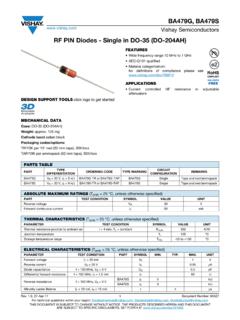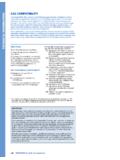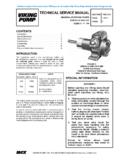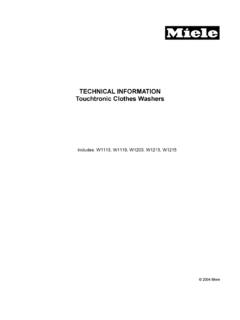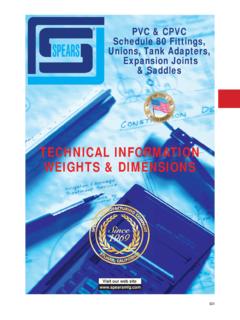Transcription of General Technical Information - Vishay
1 General Technical InformationVishay RoedersteinDocument Number 26529To contact us: 04-Sep-023 RADIO INTERFERENCE SUPPRESSION1. Origin and Spreading of Interference:There are two main sources of radio interference: Devices, which due to their construction produce RFenergy. These include generators for use in industry,medicine and science, as well as oscillators, radioand TV receivers etc. Devices, which produce a wide spectrum offrequencies, due to rapid variations in electricalcurrent intensity. These include devices with switchingcomponents, thyristors, triacs, commutators from source to receiver is spread in three ways:alonwiringby coupling, andby radiationTo frequencies of 30 MHz approximately, interference isspread mainly along the installed electrical wiring.
2 In thisrange inductive and capacitive coupling also occurs betweenthe wiring and other metal parts of the devices acting assupports of interference higher than 30 MHz are spread by radiationsince interference source dimensions and terminal wiringare in order of size to the wave length of the radiatedinterference. The metal parts therefore act as device connected to the mains supply produces twokinds of interference currents, running along wiring as seenin figure interference current B runs in differentdirections in the phase and neutral interference current A runs in the samedirection in both leads and ends in the same device via theearthing connection.
3 An earthing connection can either bean earthing wire or capacitance between the device andthe on long or medium radio waves is generallygreater if the device is earthed. In this case impedance tothe surrounding is short circuited and the asymmetricalinterference current two types of interference appear according to durationtime; continuous interference and discontinuousinterference. The latter occurs as impulses with less effectthan continuous interference. They are treated andsuppressed from continuous interference separately. Exactdefinitions are given in the regulations 55 011 CISPR 11,EN 55 014 CISPR 14-1 Radio Interference Suppression CapacitorsIntroduction2.
4 Maximum Permitted Interference Limits:In order to guarantee good operation of communicationaland other equipment, radio interference must be tolerablylimited. Interference produced from the source aremeasured as follows: Up to frequency 30 MHz, interference voltages aremeasured which spread along the terminal in thesupply network. Above 30 MHz, strength of radiated field or radiatedpower on the terminal in the supply network levels of interference are given in the nationaland international regulations. Recommendations given byCISPR (Comit International Sp cial de PerturbationRadio lectriques) are as follows:EN 55 011 CISPR 11,EN 55 014 CISPR 14-1 ) Asymmetrical TerminalVoltage/CurrentB) Symmetrical TerminalVoltage/CurrentBA/2A/2 InterferenceSourceGAB55 1 5 10 30 100 3001009080706560565045403020 Interference VoltageInterference PowerMHzdB( V) General Technical InformationVishay contact us: Number 265294 Revision 04-Sep-023.
5 Suppression Capacitors Class X and/or Y ?The suppression capacitor is the most effective interferencecomponent. Its impedance decreases with the frequency,so that we have a short circuit between the mains terminalsand/or between the terminals and ground at high for applications between the mains terminalsare called:X-CapacitorsClass X-capacitors, X-capacitors for short, are capacitorswith unlimited capacitance for use where their failure dueto a short circuit would not lead to the danger of an for applications between terminals and groundare called:Y-CapacitorsClass Y-capacitors, Y-capacitors for short, are capacitors,which serves to reduce the asymmetrical interferencevoltage, and are located between a live conductor and themetal case which may be : The high electrical and mechanical reliabilityintended to prevent short circuits in the capacitors.
6 Thelimitation of the capacitance of all Y-capacitors is intendedto reduce the AC Voltage of the current flowing through thecapacitor and in the case of DC voltage the energy contentof the capacitor to a safe fulfilling their Technical function in electrical equipment,machines and installations, Y-capacitors bridge industrialinsulating systems whose reliability, in conjunction with anadditional protection measure prevents danger to humanbeings and are intended for use in circumstances where failureof the protection measures of the equipment could lead toa danger of electric X- and Y-capacitors combined in the same caseare called:XY-CapacitorsExamples.
7 Examples of radio interference suppressionwith X- and Interference Suppression CapacitorsFigure a) An example of radio interference suppressionwith X- and Y-capacitors used in equipment belonging toprotection class b) An example of radio interference suppression withX- and Y-capacitors used in equipment belonging toprotection class a) shows the radio interference suppression of themotor of a piece of electrical equipment (vacuum cleaner,portable drill, etc.) of protection class I. Capacitor Cx, whichis used for reducing the symmetrical interference voltage,is located between the conductors of the mains and istherefore an X-capacitor.
8 Its failure through a short circuitcauses no danger of an electric b) shows an appliance or protection class II whereno protective conductor is connected to the metal case G .In both instances, a short circuit of the Y-capacitor will onlyendanger a person touching the appliance if at the sametime, either the protective conductor of protection class I isbroken or the casing insulation is damaged in the case ofprotection class capacitor CX, which is used for reducing the symmetricalinterference voltage, is located between the conductors ofthe mains and is therefore a class X-capacitor. First failuresthrough a short circuit cause no danger of an electric Technical InformationVishay RoedersteinDocument Number 26529To contact us.
9 04-Sep-025 SUBTYPE OFRANGEPEAK IMPULSECLASS INSULATION BRIDGEDOF RATEDVOLTAGE UPVOLTAGESBEFORE ENDURANCE TESTD ouble Insulation orY1 Reinforced 250 Insulation or 150 250 VBasic Insulation or 150 VY3 SupplementaryNoneInsulation 250 VBasic Insulation orY4 Supplementary 150 Interference Suppression CapacitorsSUBPEAKIEC 664 APPLICATIONPEAKCLASSIMPULSE INSTALLATIONIMPULSEVOLTAGECATEGORYVOLTAG EINUPSERVICEAPPLIEDBEFOREENDURANCETESTWh en CR 1 F> PulseUP = 4kVX1 III CR > 1 F UP = 4 CR in kVWhen CR 1 FGeneralUP = CR > 1 F UP = CR in kVGeneralX3 : CR is in FClass Y - capacitorsClass Y - capacitors are further subdivided into foursubclasses Y1, Y2.
10 Y3 and Y4 NOTE: For definitions of basic, supplementary, double andreinforced insulation see IEC 60536, sub-clauses , , and Y-capacitor may bridge basic insulation. One Y-capacitor may bridge supplementary insulation. If combinedbasic and supplementary insulations are bridged by two Y2,Y3 or Y4 capacitors in series, they shall have the samenominal to the regulations IEC 60384-14, second edition,1993-07, and/or EN 132 400, 1994, all capacitors subclassX2 have to withstand the following types of test, they shallhave the same nominal value:Impulse voltage test with UP = :(this test has to be performed before the endurance test) ( S)Endurance Test:All capacitors have to be tested for 1000 hours at the uppercategory temperature with a voltage of times ratedvoltage (UR).
